Beet and Lentil Stew with Sweet Onions
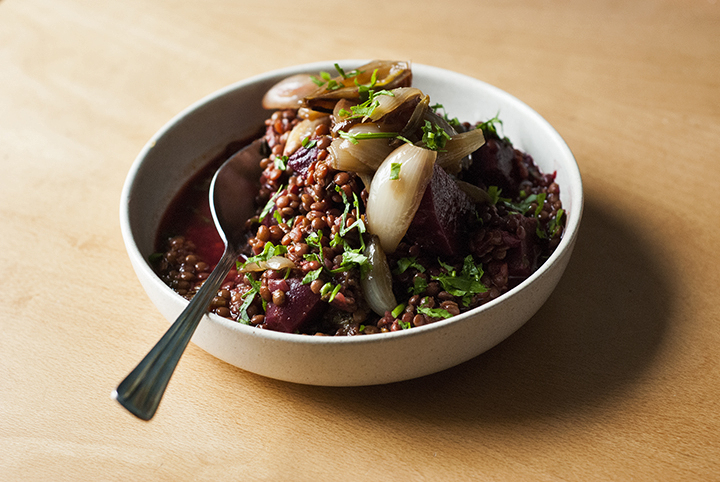 When I was younger, my mom would cook for me a few times, particularly if I was busy studying. She didn’t like to cook, but there were a couple of dishes she made that I absolutely loved. One of them consisted, basically, of beets and onions. She’d use those pre-cooked beets they sell on the supermarkets and sautée them in olive oil along with roughly chopped onions. At the very last minute of cooking, soy sauce and a good splash of red wine vinegar were stirred in. The final dish looked terribly unappetising but tasted incredibly good. The sweet and caramelised onions were a nice contrast to the chunks of beetroot, and the light sourness the red wine vinegar coated the vegetables with really sold the deal for me.
When I was younger, my mom would cook for me a few times, particularly if I was busy studying. She didn’t like to cook, but there were a couple of dishes she made that I absolutely loved. One of them consisted, basically, of beets and onions. She’d use those pre-cooked beets they sell on the supermarkets and sautée them in olive oil along with roughly chopped onions. At the very last minute of cooking, soy sauce and a good splash of red wine vinegar were stirred in. The final dish looked terribly unappetising but tasted incredibly good. The sweet and caramelised onions were a nice contrast to the chunks of beetroot, and the light sourness the red wine vinegar coated the vegetables with really sold the deal for me.
I haven’t eaten the onion and beetroot stir-fry for a couple of years now. Not that I couldn’t make it myself, but simply because I know that, if I made it, it wouldn’t taste like hers. It’s funny how we attach feelings to food and food to memories, and how those connections can indeed have an impact on our palates. As much as we might want to rationalise the experience of eating, there’s no way we can judge and evaluate food without our personal beliefs and stories sneaking in unconsciously.
The other day, I was reminded of the beetroot-onion dish while watching Nigel Slater cooking. He was making a really good-looking lentil stew with caramelised onions on top. The moment I saw it, I knew I had to make my version of it. And, as it turns out, my version is a mix of mom’s signature dish and Nigel’s recipe. Personally, I think it tastes divine. The key is to choose the right lentils – use a variety that doesn’t collapse while cooking, such as Puy, for some texture. Equally important is not to skip the cinnamon, as it gives the stew that comforting and warming character all winter meals should have.
Beet and Lentil Stew with Sweet Onions
(serves 4, as a main)
For the stew:
635 gr / 6 medium sized beets, peeled and quartered
315 g green or puy lentils / 1 ½ cups
1 large onion / 180 g cut into thin half moons
4 garlic cloves, finely chopped
2 tablespoons olive oil
1 teaspoon sweet paprika
½ teaspoon cinnamon
1/8 teaspoon freshly grated nutmeg
½ teaspoon salt
625 ml / 2 ½ cups reduced sodium vegetable stock
625 ml / 2 ½ cups water
1 bunch / 12 g parsley, finely chopped
For the sweet onion topping:
470 g / 7 small onions, peeled and quartered
1 tablespoon olive oil
1 tablespoon red wine vinegar
salt to taste
freshly grated nutmeg to taste
In a large pot over over low-medium heat, add the olive oil, garlic and onion. Fry for 2-3 minutes or until the onion is soft and translucent. Add the paprika, cinnamon and nutmeg and fry for one additional minute.
Add the beets, the stock and the water to the pan and bring everything to a boil. Once boiling, decrease the heat to low-medium and cook, covered, for 30 minutes.
After half an hour, add the lentils and the parsley. Simmer for additional 30 minutes. When the lentils are cooked, stir in the salt and serve with the onion topping (recipe follows) and cooked brown rice.
For the sweet onion topping: add, to a non-stick frying pan over low-medium heat, the olive oil, onions and a pinch of salt. Put a lid over the pan and let the onions cook for 20 minutes, stirring occasionally, until they’re caramelised. At the very last minute of cooking, add the nutmeg and the red wine vinegar. Give everything a good stir and serve over the stew.
Recipe inspired by Nigel Slater
Beetroot and Brown Rice Burgers
I have bookmarked Louisa Shafia’s Beet Burgers a long time ago, and never really got the chance to make them. The other day, while flipping through my notebook, I found the said recipe, that I’ve spotted on her blog and immediately did a quick annotation of the ingredients list to make it. But then, some other plans have crossed my mind and the recipe remained written, but untested. So, this week, having a couple of extra-large beetroot sitting on the fridge, I finally gave Louisa’s burgers a try. And after bitting into one of them, I kept asking myself why haven’t I made the burgers sooner – not only they have the perfect texture and right consistency, but are also packed with flavor. In one word: delicious.
Now, I know there’s a lot of you out there who don’t like beetroot. Some of you, might even hate the poor vegetable. But even with beetroot haters like my mum, the burgers were a huge hit. Now that I think about it I realize they actually don’t taste to beetroot that much – the addition of nuts, caramelized onion, and some spices, not only gives them texture and crunch, but also a delicious, kind of hearty taste, that somehow balances out the natural sweetness of the beetroot. I’ve made a couple tweaks to the original recipe though: substituted the walnuts called for in the original version for a mix of nuts and seeds, and instead of baking the burgers and searing them as suggested, I managed to save some time up by pan-frying them straight away without sacrificing texture – in the end, you still get a well-cooked inside and crunchy outside, the basic requirements for a perfect burger. I’m sure I’ll be making these again, and maybe next time, experimenting with different grains - substituing the brown rice for millet, for example.
Beetroot and Brown Rice Burgers
(makes 6 burgers)
1/4 cup of EACH: sunflower seeds, pumpkin seeds, flax seeds and cashew nuts
2 cups grated beetroot (from approximately 1 large beetroot)
1 1/2 cups COOKED brown rice
1 large white onion, sliced into rings
5 tablespoons olive oil
1 tablespoon paprika
1 teaspoons ground cumin
freshly ground black pepper, to taste
1 teaspoons salt
1. After grating the beetroot, place them in a colander and squeeze out all the liquid. Discard the liquid and set aside. Alternatively, you can use the liquid - like I did - to make a juice and/or a smoothie.
2. Heat a large pan over medium heat, add the onion and 2 tablespoons of the olive oil and cook, stirring often, for at least 10 minutes, or until the onion starts browning and caramelizing. While the onion is cooking, add the paprika and ground cumin to the pan, as well as a pinch of salt and freshly ground pepper.
3. In a large food processor, add the cooked rice, 1 cup of the grated beetroot and 1 teaspoon of salt, and process for about 2 minutes, or until it has the consistency of a thick puree. This will work as a binder.
4. Add the cooked onion and all the different nuts and seeds to the food processor and pulse no more than 3 times. You want the burgers to have some texture and crunch, so this mixture only needs to be broken down a bit.
5. Add the puree to the remaining 1 cup of grated beetroot and mix well until incorporated. Have a taste and salt a bit more, if needed be. The mixture should be thick and easy enough to handle and shape into patties.
6. Divide the mixture into 6 equal portions. With your hands, form round patties that are about 8 centimeters in diameter and 1 centimeter thick. At this point, you can keep the burgers refrigerated for 2 to 3 days and cook them within that time.
7. Heat a large non-stick frying pan over medium heat, and add 3 tablespoons of olive oil. When the oil is hot, but not smoking, add the burgers. Pan-fry them for at least 6 minutes on each side, turning them only once.
8. Serve the burgers right after cooking with your favorite fixings. I’ve topped mine with chutney and lots of fresh parsley.
adapted from Lucid Food
Roasted Beetroot Soup with Cumin Potatoes
Everybody’s seem to have some kind of issue with beetroot. Some people only can eat them in salads, mixed with other veggies, some others can’t really stand them, and then there are those individuals (aka me) that could live on beetroot for the rest of their lifes and remain totally happy (well, sort of…).
I’d argue that the best way to cook beetroot is to roast them, as roasting enhances their sweet flavor and also adds a bit of a smoky taste. Roasting the beetroot is the step that will take longer when making this soup, but I assure you it is totally worth it. Apart from that, the soup couldn’t be more simple to make: just put the required ingredients on the food processor, blend until smooth, serve, eat. The addition of dill complements well the sweetness of the beetroot, and the crispy potatoes, with their hint of cumin, add crunchiness and depth to the soup. As I specify in the directions, you can adjust the amount of water to your liking (the amount mentioned makes for a soup on the thick, creamy side, as it is how I like mine), but bear in mind that if you thin it, you’ll probably have to adjust the seasonings afterwards.
Roasted Beetroot Soup
(serves 2 to 3, depending on the consistency you want your soup to have)
350 grams raw beetroot
200 grams natural unsweetened soy yoghurt
1 tablespoon olive oil
1 teaspoon salt
1 small garlic clove
3 tablespoons finely chopped dill, plus a bit more for garnish
1/3 cup water
for the cumin potatoes:
260 grams waxy potatoes (about 2 large), peeled and cubbed
¾ teaspoon ground cumin
a pinch of salt
1 tablespoon olive oil
1. Preheat the oven to 180ºC.
2. Place the beetroot in a baking tray lined with parchment paper. Sprinkle the beetroot with salt, and roast for at least 1 hour, or until tender.
3. Let the beetroot cool a bit before handing them. Then peel them under running cold water and cut into small cubes.
4. In a food processor, combine the cubbed beetroot, soy yoghurt, garlic clove, olive oil, dill, and water, and process until smooth. Taste, adjust the seasonings, and if the soup seems too thick, add a bit more water to thin it to your liking. Taste and adjust the seasonings, adding a bit more salt if necessary.
5. Divide the beetroot soup among 2 or 3 bowls. Set aside.
6. To make the cumin potatoes, heat 1 tablespoon of olive oil in a large frying pan over medium-high heat, then add the potatoes, salt and ground cumin. Cook, covered, for approximately 15 minutes, giving the pan a good shake every 5 minutes. They’re ready when crisp and uniformly golden brown.
7. To serve, scatter 2 or 3 tablespoons of the potatoes over each bowl of soup. Sprinkle each bowl with a bit more dill and serve immediately. The soup can be enjoyed cold or at room temperature, although I prefer the latter.
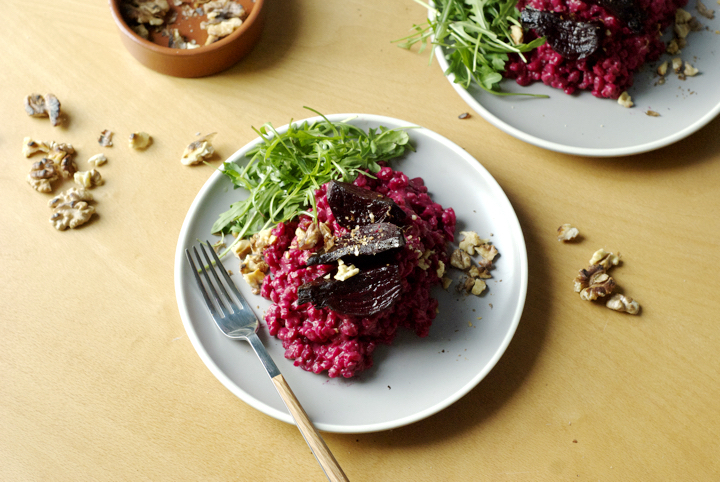
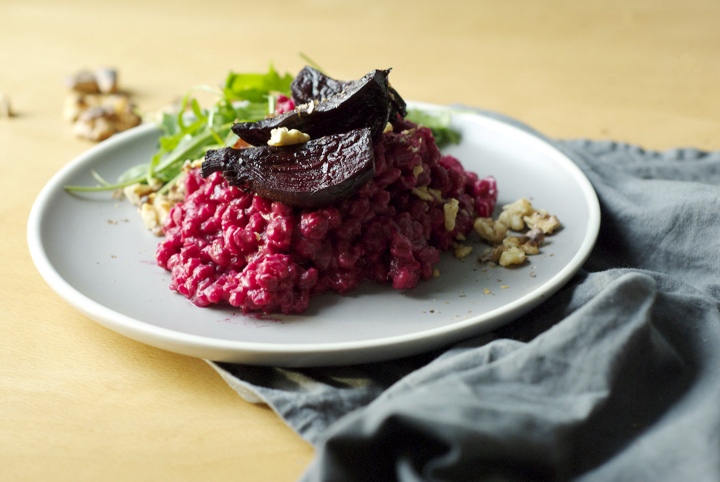
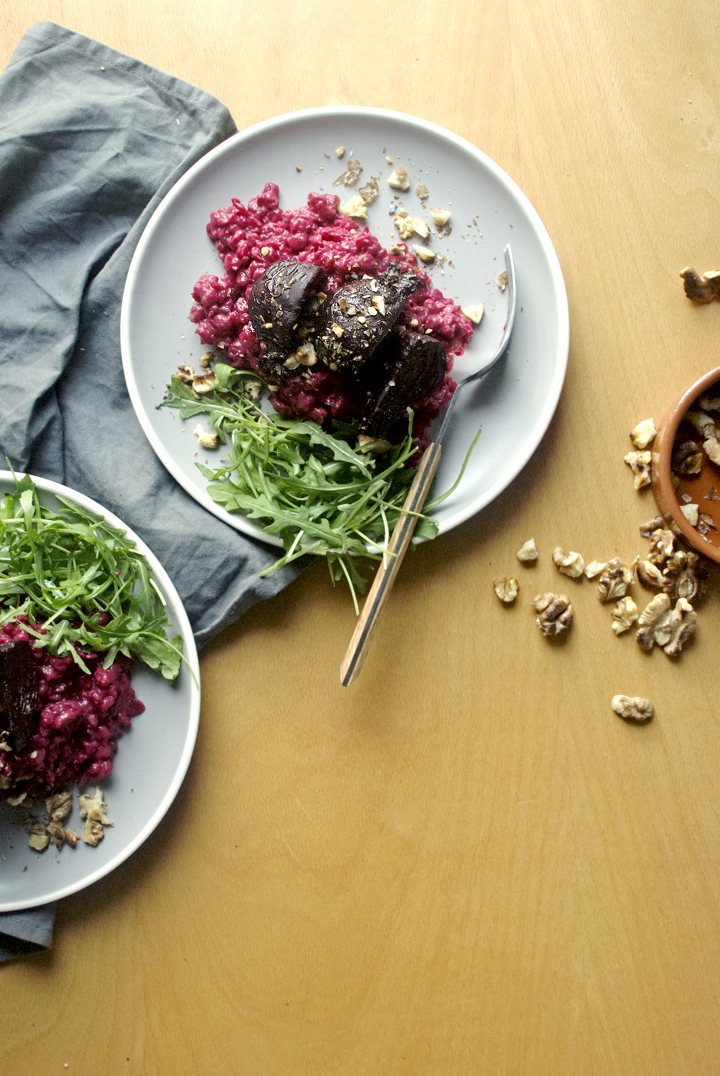
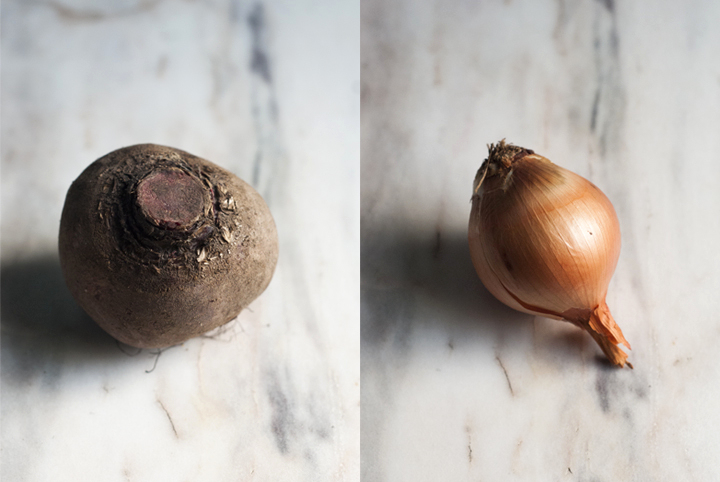
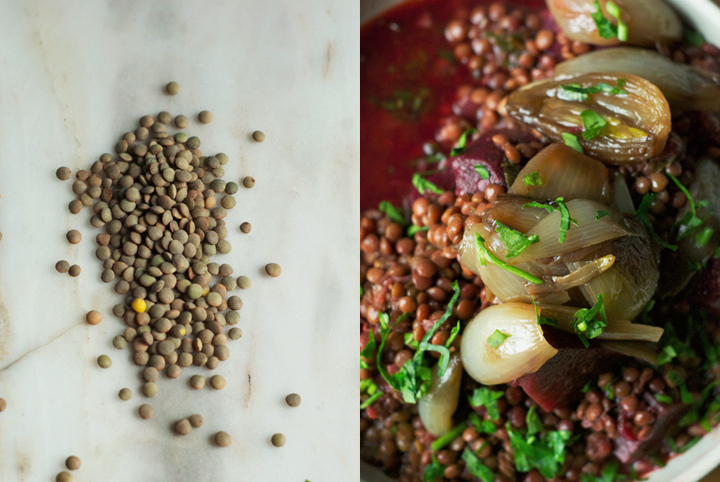
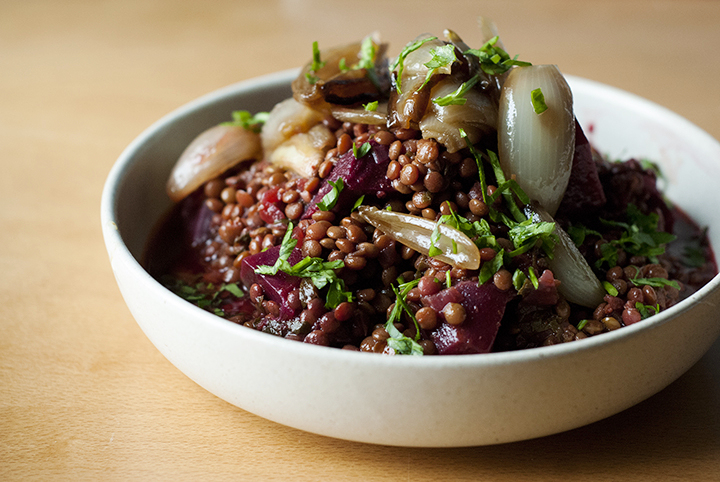

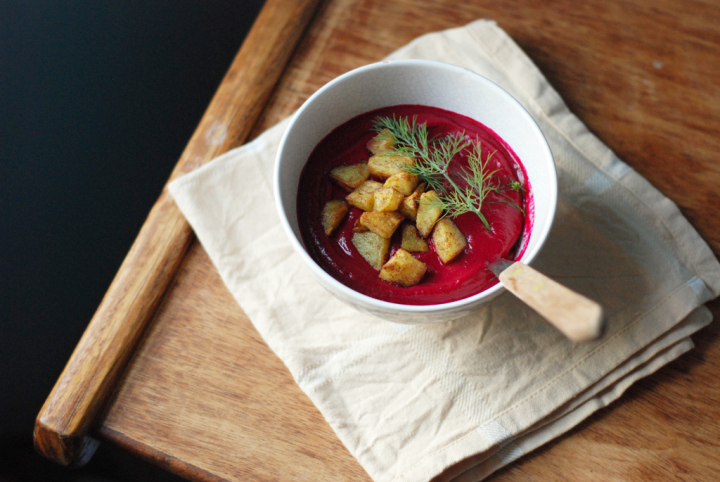
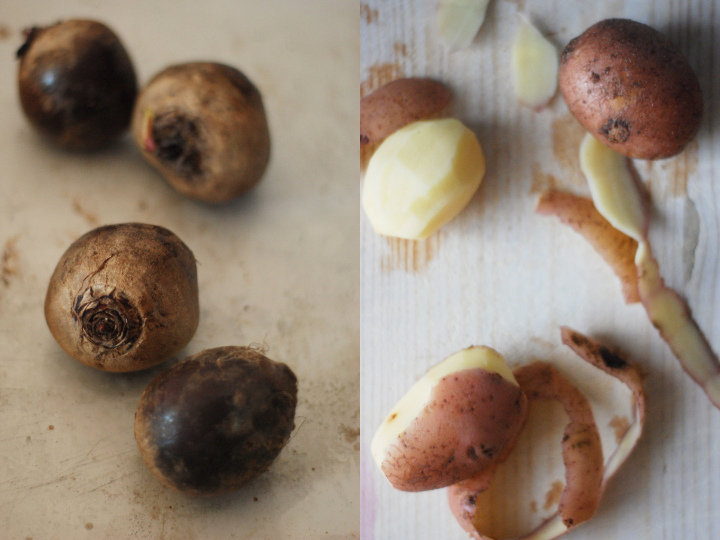
3 comments